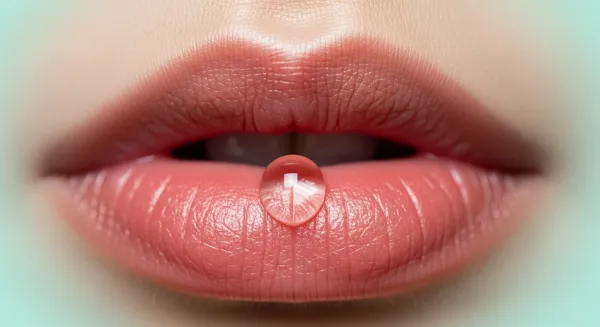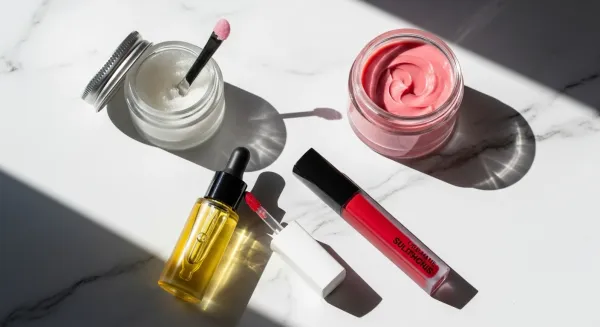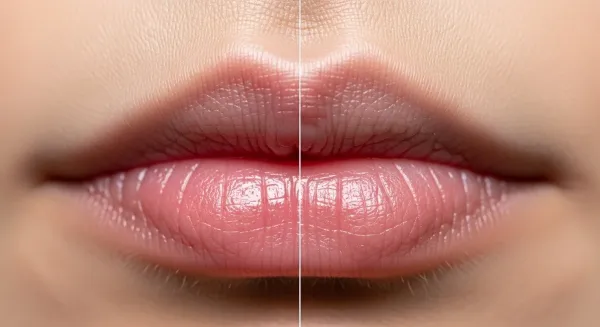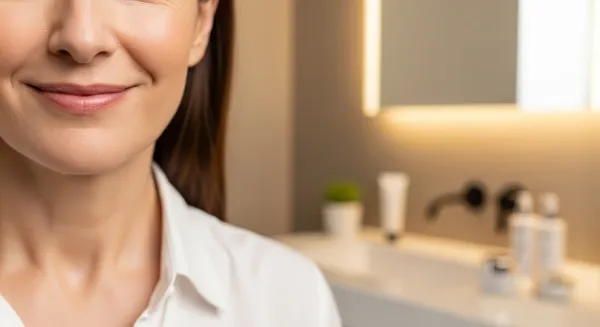Winter Lip Care: The Ultimate No-BS Guide to Preventing and Healing Cold Weather Damage
Stop suffering from painful, chapped lips this winter. Our expert guide covers prevention, healing treatments, and the best ingredients for healthy lips.
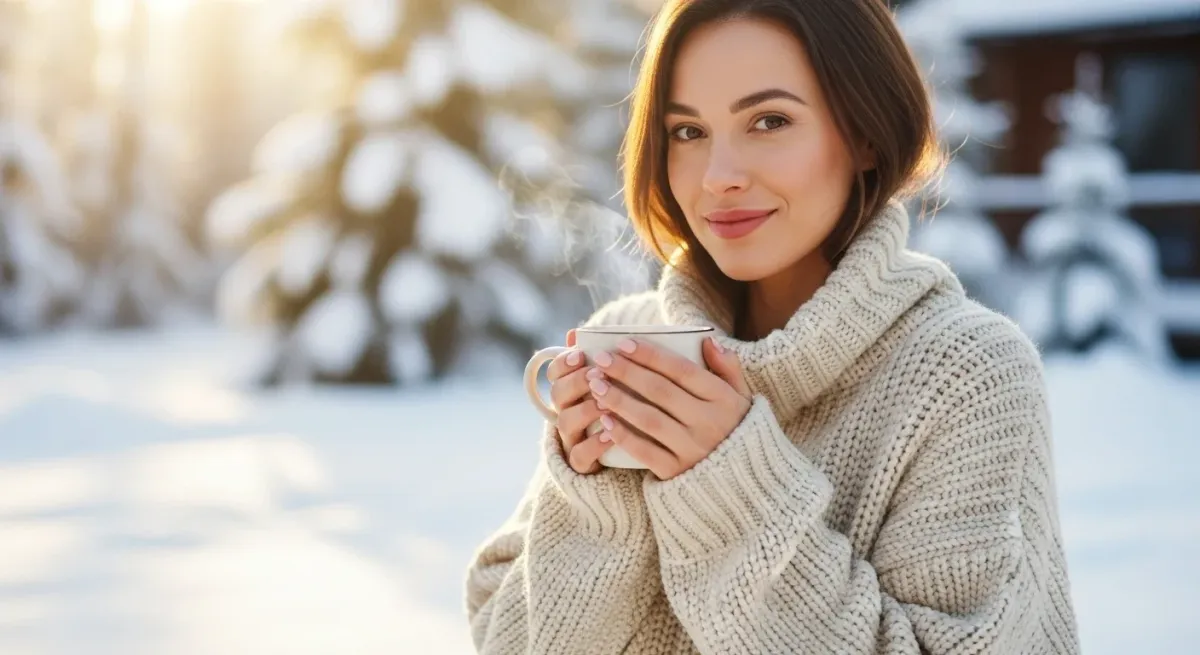
Lip care in winter: preventing and treating cold weather damage is something 90% of people get wrong. And I'm going to show you exactly why your lips crack, bleed, and hurt like hell every winter—and more importantly, how to fix it for good.
Winter Lip Care — No‑BS Guide (Quick Summary)
TL;DR
Winter wrecks lips via low humidity + wind + habits
- No oil glands: lips dry faster than skin → need constant seal.
- Saliva trap: lip‑licking makes it worse; enzymes irritate.
- Simple stack beats 10 balms: humectant → emollient → occlusive + SPF.
- Indoors counts: heat drops RH; run a humidifier to 40–50% at night.
- Fix triggers first: fragrances/flavors, menthol/camphor, minty toothpaste, long‑wear mattes.
If severe cracking, yellow crusts, or >4 weeks no change → see a clinician.
Here's the brutal truth: You're probably making your chapped lips WORSE right now. The lip balm in your pocket? It might be the problem. That thing you do when your lips feel dry? Huge mistake.
But don't worry. I'm going to give you the exact system I use to keep my lips perfect all winter long. No fluff. No maybes. Just what works.
The Real Science Behind Your Cracked Lips (And Why They Hurt So Much)
Let's start with what's actually happening to your lips.
Your lip skin is insanely thin—like tissue paper compared to the rest of your face. And here's the kicker: your lips have ZERO oil glands. None. Zip. Nothing.
Think about that for a second. Every other part of your skin produces oil to protect itself. Your lips? They're out there naked, fighting winter with no backup.
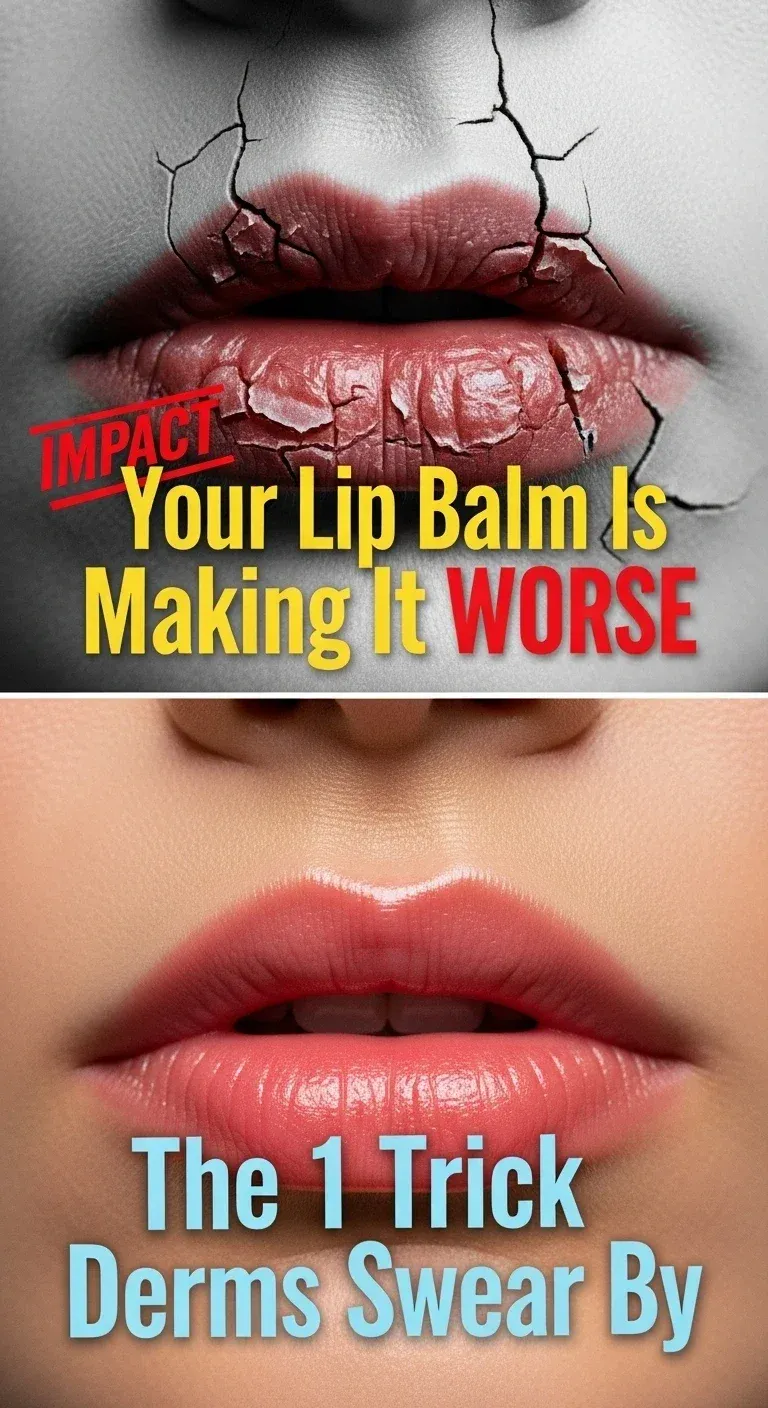
Now add cold air, wind, and indoor heating. These create something called Transepidermal Water Loss (TEWL)—fancy words that mean moisture is escaping from your skin faster than you can say "chapped lips."
According to the American Academy of Dermatology, your lips are uniquely vulnerable because they lack the protective sebaceous glands that keep the rest of your skin moisturized.
But here's where it gets worse. You know what you do when your lips feel dry? You lick them. And that's like throwing gasoline on a fire.
Why licking makes everything worse:
- Saliva contains digestive enzymes meant to break down food
- These same enzymes destroy your lip's protective barrier
- When the saliva evaporates, it takes even MORE moisture with it
- You're literally eating your own lips
Stop doing it. Seriously. Stop right now.
The Lip Care Myths That Are Destroying Your Lips
Let me bust the biggest myth right here: You're NOT addicted to lip balm.
Everyone says, "Oh, you use lip balm too much, you'll get addicted." That's complete garbage.
Here's what's really happening:
- Your balm probably has irritating ingredients (camphor, menthol, or fragrance)
- These ingredients feel tingly and "fresh" but damage your skin
- Your lips get MORE damaged, so you need MORE balm
- It's not addiction—it's a cycle of irritation you created
The solution? Get a better balm with simple, healing ingredients. We'll cover exactly which ones in a minute.
Other myths I need to kill:
- "My lips need to breathe" - They don't have lungs. They need protection.
- "Expensive = better" - Wrong. A $3 tub of Vaseline often beats $30 lip masks.
- "I should exfoliate daily" - No! Only when they're soft, never when raw.
Your AM/PM Winter Lip Routine (The Only System You Need)
Stop guessing. Here's the exact routine that works.
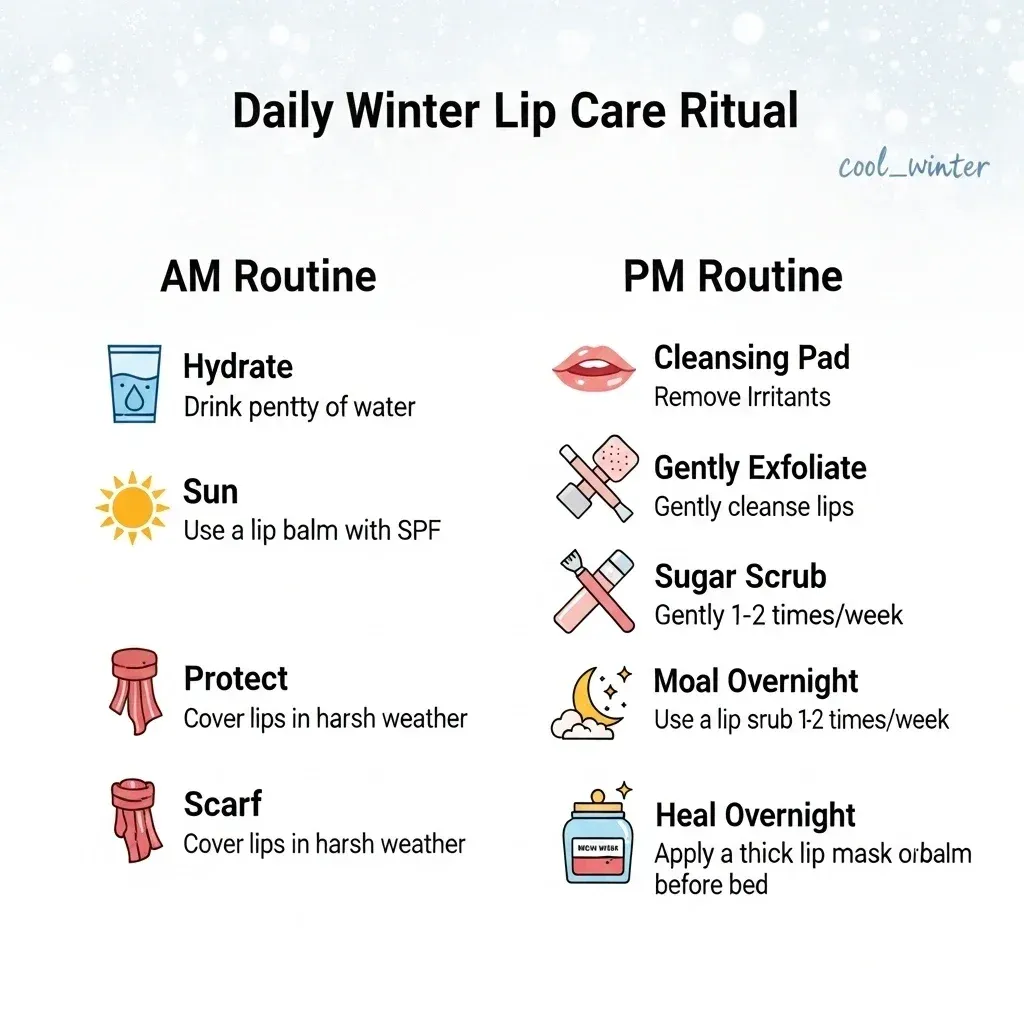
Morning Routine (Takes 60 Seconds)
Step 1: Drink water as soon as you wake up
- Not coffee. WATER.
- Internal hydration matters more than any product you'll buy
Step 2: Gently wipe lips with a warm, damp cloth
- Removes dead skin without scrubbing
- Softens lips for better product absorption
Step 3: Apply balm with SPF before you step outside
- Winter sun still damages your lips
- SPF protection isn't just for summer
- Put it on BEFORE you need it, not after your lips hurt
Night Routine (The Real Game-Changer)
Step 1: Remove all lip color thoroughly
- Leftover makeup dries you out overnight
- Use a gentle oil-based remover
Step 2: Apply a THICK layer of healing ointment
- This is your overnight mask
- Think Vaseline, Aquaphor, or similar petroleum-based products
- You want it to look excessive—that's the point
Step 3: Sleep and let it work
- Your lips repair themselves while you sleep
- That thick layer locks in moisture for 8 hours straight
The Lip Care Arsenal: What to Buy (And What to Avoid)
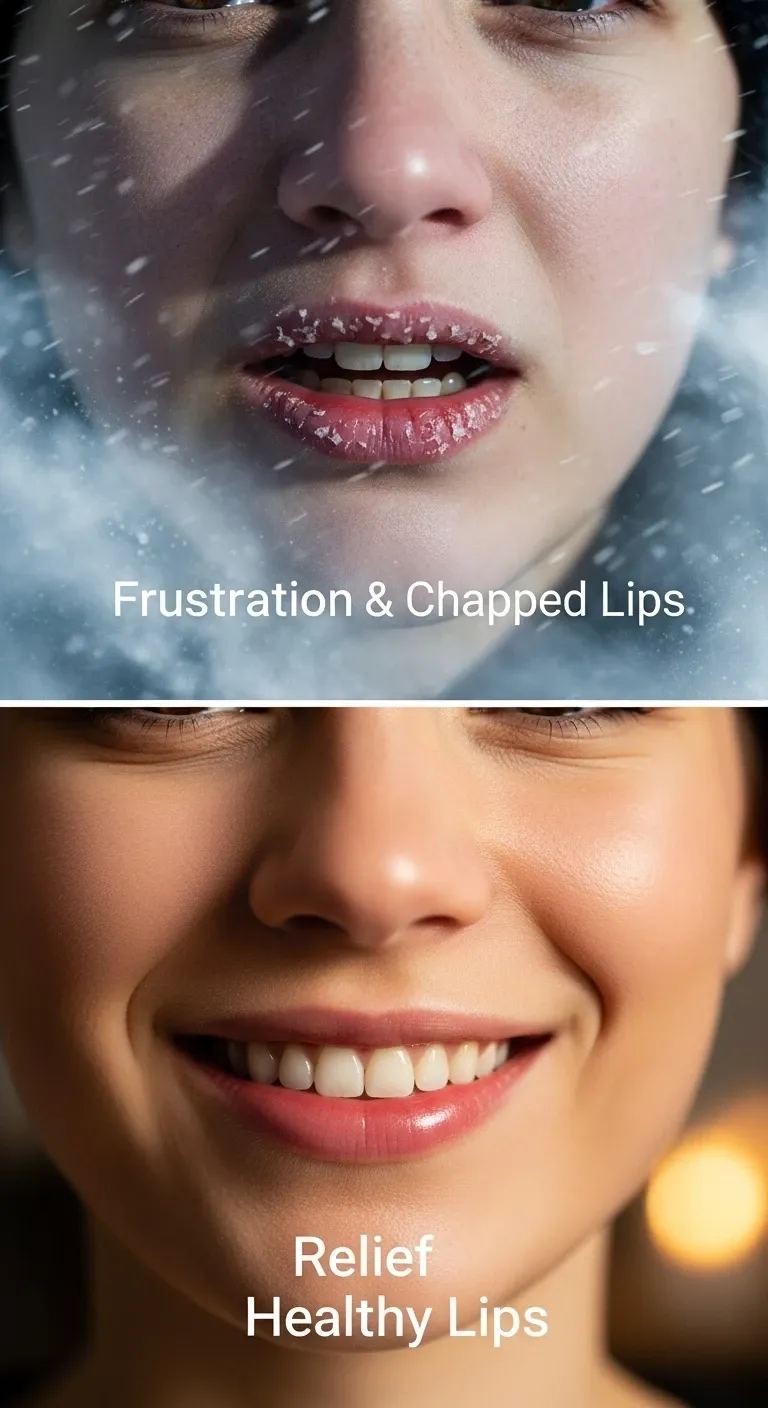
Here's a breakdown of products and when to use them:
| Product Type | When to Use | Key Features | Best For |
|---|---|---|---|
| Lip Balms (sticks/tubes) | Daily, multiple times | Portable, quick application | On-the-go protection |
| Lip Ointments (pots) | Night, intensive healing | Heavy-duty, occlusive | Severe chapping, overnight |
| Lip Masks | 1-2x per week | Specialized active ingredients | Extra TLC, prevention |
| Lip Scrubs | Weekly max, when lips are soft | Gentle exfoliation | Removing dead skin safely |
The Ingredients That Actually Work
Look for these heroes:
- Petrolatum - The GOAT. Nothing seals moisture better.
- Shea Butter - Natural emollient that actually heals
- Beeswax - Creates a protective barrier
- Glycerin - Pulls moisture from air to your lips
- Dimethicone - Smooth, protective silicone
Run from these villains:
- Camphor (it tingles = it's irritating you)
- Menthol (same problem)
- Phenol (drying agent disguised as medicine)
- Strong fragrances (unnecessary irritation)
- Lanolin (if you're allergic, this makes things WORSE)
The Humectant Trap (Critical Warning)
Pay attention here because this is where most people screw up.
Humectants like hyaluronic acid and glycerin are great—but ONLY when sealed with an occlusive.
Here's why: In super dry winter air, humectants can actually PULL moisture from the deeper layers of your lips if there's no moisture in the air to grab.
The right way to layer:
- Apply humectant (hyaluronic acid serum)
- IMMEDIATELY seal with occlusive (Vaseline)
- Don't wait—trap that moisture RIGHT NOW
The Emergency Protocol for Severely Damaged Lips
Your lips are cracked, bleeding, and painful. Here's exactly what to do:
Day 1-3: STOP THE DAMAGE
- No lipstick, no matte anything
- Cancel the exfoliation—seriously, stop
- Apply healing ointment every 2 hours
- Use the "soak and seal" method: wet lips with warm water, pat gently, immediately apply thick ointment
Day 4-7: GENTLE HEALING
- If there's peeling skin and lips are soft (not raw), do ONE gentle exfoliation with a damp washcloth
- Continue aggressive moisturizing
- Add ceramides to rebuild your skin barrier
Day 8+: MAINTENANCE MODE
- Switch to prevention routine
- Keep that overnight ointment going
- Never let your lips feel dry—reapply before they hurt
Warning signs you need a doctor:
- No improvement after 2-3 weeks of proper care
- Cracks at the corners of your mouth (angular cheilitis)
- Signs of infection (oozing, excessive redness, fever)
- Persistent unusual discoloration
How to Wear Lipstick in Winter Without Destroying Your Lips
You don't have to give up lipstick. You just need to do it smarter.
The proper lipstick protocol:
- Prime with a thin layer of balm (wait 2 minutes to absorb)
- Choose hydrating formulas over matte
- Blot and reapply rather than adding thick layers
- Remove COMPLETELY before bed with oil-based remover
- Do overnight treatment immediately after removal
Product types ranked (best to worst for winter):
- Tinted balms - Best option
- Cream lipsticks - Good if you prep properly
- Liquid lipsticks (hydrating formula) - Okay with prep
- Matte liquids - Only if you're a pro at prep and removal
Special Situations: Athletes, Kids, and Chronic Conditions
For Winter Athletes (Skiers, Runners, Snowboarders)
Your situation is extreme. Here's what to do:
- Use a thick, white zinc oxide barrier before activity
- SPF 50+ minimum
- Reapply every 2 hours, no exceptions
- Protect like your face depends on it
- Physical coverage (balaclava) is your friend
For Kids with Chapped Lips
The routine is similar but simpler:
- Keep it to petroleum jelly—it's safe and effective
- Apply before school, after school, before bed
- Teach them NOT to lick (good luck)
- If it persists, see a pediatric dermatologist
For People with Eczema, Psoriasis, or Autoimmune Issues
Your lips need extra TLC:
- Work with your dermatologist for a custom plan
- Fragrance-free everything
- Repair your skin barrier first
- Expect slower healing—that's normal for you
- Don't compare your timeline to others'
FAQ: The Questions You're Actually Asking
Q: How long until my severely chapped lips heal? A: With proper care, 1-2 weeks. If you keep licking and using bad products, never.
Q: My new lip balm stings a little. Does that mean it's working? A: HELL NO. It means it's irritating you. Throw it out. Healing shouldn't hurt.
Q: Can I just use my regular face moisturizer on my lips? A: You can, but it's not ideal. Most face creams aren't occlusive enough for lips. They'll feel better temporarily, then dry out again.
Q: What's the real difference between a $3 lip balm and a $30 lip mask? A: Often? Marketing. Sometimes the expensive one has better active ingredients, but petroleum jelly is still the MVP.
Q: How do I know if I have chapped lips or a cold sore? A: Cold sores are small blisters, usually on the edge of your lips. They tingle before appearing and are caused by a virus. Chapped lips are dry, cracked, and happen across your whole lip.
Q: Are DIY lip scrubs safe? A: If you use gentle ingredients (sugar + honey) and apply VERY gently on soft, not-raw lips, yes. But honestly? Just use a damp washcloth. It's free and works just as well.
The Bottom Line (What Actually Matters)
Here's everything you need to remember:
The non-negotiables:
- Stop licking your lips RIGHT NOW
- Apply protection BEFORE going outside, not after damage happens
- Layer properly: humectant → occlusive
- Do the overnight ointment treatment every single night
- Stay hydrated internally—water matters
The game-changers:
- Finding ONE good ointment and using it consistently
- Breaking the lick-dry-lick cycle
- Building your overall skin barrier health
- Prevention beats treatment every single time
The reality check: You don't need 15 products. You need:
- A good SPF balm for daytime
- A thick ointment for nighttime
- The discipline to use them consistently
That's it. Stop overcomplicating it.
Your lips didn't get destroyed in one day, and they won't heal in one day. But if you follow this system, you'll see real improvement in less than a week.
Now go fix your lips. Winter doesn't have to suck.
FAQ — Winter lip care
No fluff. What works in the cold.
Lock in moisture and block the elements. Use a simple balm or ointment with petrolatum or dimethicone AM, PM, and before going outside. Reapply every 2 hours outdoors. Don’t lick or pick. Run a humidifier at home and cover your mouth with a scarf in wind and cold.
Look for occlusives and skin soothers: petrolatum, dimethicone, shea butter, ceramides. For sun, choose SPF 30+ with zinc oxide or titanium dioxide. Skip fragrance, flavor (mint/cinnamon/citrus), menthol, camphor, eucalyptus, and salicylic acid. Some people react to lanolin—test first.
Go gentle. If lips are cracked or bleeding, do not scrub—hydrate only. When lips are smooth, you can lightly buff 1–2x/week, then seal with a thick balm. The main play is protection and reapplication, not aggressive exfoliation.
Use a thick layer of plain petrolatum or a non‑irritating balm several times a day and before bed. Reapply every 2 hours outside and after eating or drinking. Stop licking and biting. Add a home humidifier. If lips stay sore, swollen, or don’t improve, get checked.
Yes. UV hits year‑round and snow reflects it. Use a lip product with SPF 30+ and reapply every 2 hours outdoors. Mineral filters (zinc oxide or titanium dioxide) are solid picks, especially for sensitive skin.
Ready to optimize your entire skincare routine? Check out our complete winter skincare guide and learn how to protect every part of your skin during cold weather.

